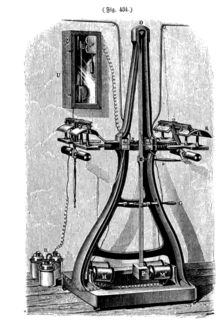Pantelegraph

The Pantelegraph is a historical, electromechanical fax machine that was invented by Giovanni Caselli and patented by him in 1855. The Pantelegraph was used for line-by-line reception and line-by-line transmission of image information via the telegraph lines that were common at the time and used electrochemical processes for mapping . In the United States, Caselli received a patent on his invention on June 29, 1858.
functionality

The sender of an image first reproduced it on an electrically conductive metal foil with an electrically non-conductive dye (ink). This template was clamped in the transmitter unit and scanned line by line with a rocking movement of a thin, metallic needle with approx. Three lines per millimeter. In areas where no ink has been applied, the transmitter-side battery is short-circuited and the electrical voltage is low. If the needle comes into areas where the electrically non-conductive ink of the artwork prevents a short circuit, the higher voltage of the battery is the result. The template-dependent electrical voltages caused in this way can be transmitted over a simple telegraph line up to a distance of several 100 km to the receiving unit.
The Pantelegraph working as the recipient uses a piece of paper that is soaked in a yellowish cyanide solution. A metallic needle is passed line by line and synchronously to the transmitter over this paper, whereby a chemical reaction is triggered by the different high voltages on the part of the transmitter in the cyanide solution: When current flows through the needle, the originally yellow cyanide compound turns into a dark blue color .
For correct imaging, it is essential that the needles on the transmitter and receiver move as evenly and synchronously as possible . This is achieved by a mechanical pendulum about 2 m to 3 m in size with a weight of 8 kg, which is triggered electromechanically by two electromagnets .
The return of the needle due to the pendulum motion required just as much time as the forward movement. This time was used by some Pantelegraphs for the transmission of a second template.
history
In 1857 Caselli left Italy for Paris. There he received support from the then famous inventor Paul-Gustave Froment . Léon Foucault recommended Caselli to contact Froment. Napoleon III, who was very interested in mechanics and modern inventions, visited Caselli on May 10, 1860, had the Pantelegraph shown to him and from then on supported Caselli. In November 1860 Caselli was given a Paris- Amiens telegraph line (115 km as the crow flies), on which he could experiment with long-distance transmission under real conditions. Foucault fixed one last problem by making the synchronization devices independent of the current in the telegraph line; this had made the devices too sensitive to atmospheric disturbances .
Around 1860 and in the following years, the Pantelegraph was mainly used in France for the transmission and verification of signatures in banking transactions. For this purpose it was operated primarily in post or railway stations, as the necessary connection to telegraph lines was also possible there. The Pantelegraph was also used by Napoléon III. used.
Today there are only a few existing original Pantelegraphs, including in the Musée des arts et métiers in Paris . In 1961, to mark the centenary of the Pantelegraph, these devices were used to establish a connection from Paris to Marseille .
One copy is in the non-public fund of the Deutsches Museum in Munich.
Other copies are in the Museo nazionale della scienza e della tecnologia Leonardo da Vinci (Milan, see picture), in the Istituto Tecnico Statale Giambattista Della Porta (Naples) and in the Museo storico della comunicazione (Rome).
literature
- Julia Zons: Casellis Pantelegraph: History of a Forgotten Medium . transcript, 2015, ISBN 978-3-8376-3116-6 . (Dissertation, University of Konstanz 2014).
Footnotes
- ↑ Patent EP 2532 of November 10, 1855
- ↑ US patent number 20,698 of June 29, 1858 for Giovanni Caselli (English), accessed on November 10, 2011.
- ↑ a b c Caselli’s Pantelegraph (Eng.)
- ↑ Julia Zons: Casellis Pantelegraph. P. 7 f. (shown on p. 8, (online) )
- ↑ Fig
- ↑ exhibited in room 9 , further information
- ↑ kops.uni-konstanz.de
- ↑ limited preview on Google Books
